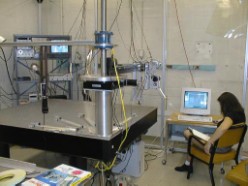PHENIX
Research
Faculty
Postdocs:
Graduate Students:
Undergraduate Students:
We are part of the
PHENIX collaboration at the Relativistic Heavy Ion Collider (
RHIC) at
Brookhaven National Laboratory. We have been involved in detector design and construction including the design and construction of the station one muon tracking chambers and the upgrade forward silicon vertex tracker, Our physics interest focuses on the unique opportunity of colliding polarized protons with polarized protons in RHIC. Measurements using the PHENIX detector have help disentangle the current puzzles and uncertainties about our understanding of one of the most fundamental properties of the proton, namely its spin. At issue is the simple and important question of how the constituents of the protons, i.e. the quarks and gluons, combine their individual spins and orbital angular momenta to the overall spin 1/2 of the proton. Our group has been involved in developing a technique to measure the contribution of orbital angular momentum to the proton's spin. In addition, as one of two major experiments at RHIC, PHENIX has been a very active participant in the relativistic heavy ion (up to Au on Au at 200 GeV/nucleon) program. Our work on the muon tracking system and the fVTX system is in close collaboration with
Los Alamos National Laboratory.
We are currently looking for qualified graduate students. Projects include working on the fVTX program in collaboration with the PHENIX group at LANL, Columbia NMSU and elsewhere, data analysis of RHIC Run06 and Run 07 data (already produced, and participation on future (yearly) RHIC runs.
The PHENIX experiment is one component of the nuclear, particle and particle-astrophysics programs of the New
Mexico Center for Particle Physics in the
Department of Physics and Astronomy at the
University of New Mexico, Albuquerque, NM 87131, USA.
